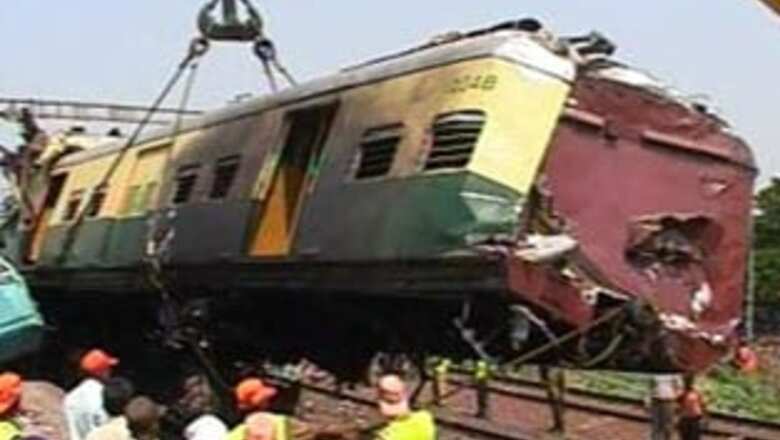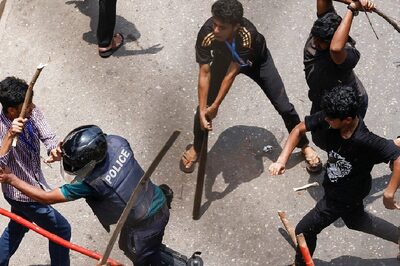
views
On the night of July 19, the 1,500-odd passengers inside the Vananchal Express had no clue of the disaster lurking behind them. It was just before 2 am. Most of them were fast asleep, unaware that their Ranchi-bound train had pulled up for a scheduled stop at Sainthia, a nondescript station in Birbhum district, about 191 km from Kolkata. Minutes later, another passenger train, the Uttarbanga Express, travelling at 90 km an hour, rammed into the rear compartments of the Vananchal Express. Media reports suggest that the collision was so severe that the roof and the sides of one of the compartments mounted the over-bridge across the tracks in the station.
Almost two weeks after the incident, it isn’t still clear why MC Dey, the driver of the Sealdah-bound Uttarbanga Express and NK Mandal, his assistant driver, had suddenly decided to rev up. Both Dey and Mandal perished in the mishap — as did A Mukherjee, the guard in the Vananchal Express. This was the sixth tragedy in the last year and the second in less than two months in the state. Almost half the rail accidents in the past have been ascribed to human error. “A human error is nothing, but a misreading of the signal by the driver or a situation when he jumps the signal because of bad weather or he is not alert or confused or is sleeping or has simply gone mad,” says a senior Indian Railways official, on conditions of anonymity. The railways, mostly, continue to rely on a manual system of signaling that is clearly far from foolproof. And so, in case the driver, the guard and the stationmaster are not in sync with each other, it could result — as it did in Sainthia — in a massive accident. “If the driver jumps the red signal then it is a disaster because today there is nothing that can stop him. There are no checks and balances,” adds the official.
Now, here’s the irony: There is a range of technological solutions that can remove the scope for human error and make the system fool-proof. The Indian Railways have experimented with a range of solutions to improve its safety record, but none of them has been scaled up nationwide either due to the lack of budget or simply because the powers-that-be had other priorities. When asked, a senior executive in the Indian railways, in charge of technology implementation, prefers to maintain a stoic silence on the issue. Former railway officials, however, are far less sanguine. “The job must be ruthlessly done and the management must not shy away from shedding blood,” says a former Chairman Railway Board who did not wish to be quoted.
So what are the options to make train travel in India safer?
The anti-collision device
In 1999, Bojji Rajaram, the former managing director of Konkan Railway Corporation had indigenously developed a local variant of the anti-collision device (ACD), also known as ‘Suraksha Kawach’. Since then, except for a single stray accident (because of a boulder that suddenly fell through on the tracks), the Konkan Railway has had a completely spotless safety record. Simply put, an ACD works on a satellite based Global Positioning System (GPS). It is nothing but an intelligent microprocessor-based system typically installed on locomotives, brake vans and at stations and level crossing gates.
All these ACDs interact with each other and exchange information when they are within their radio zones of about 3 km. In case there is another train on the same track and it strays within that safety mark, the ACDs on both trains will automatically apply the brakes and the locomotives are brought to a halt to prevent collision. Also, when approaching a station, the locomotive ACD gives the station approach warning to the driver. If the driver doesn’t acknowledge this warning, then the speed of the train is automatically regulated. “Today there is no way they can communicate. Anti-collision devices are used worldwide in rail road systems and signaling has to be linked with this,” says the former chairman Railway Board official.
Now, the Indian Railways has been toying with the idea of implementing the ACD but it has never got down to seriously implementing it. In 2006, the ACD was successfully implemented in the North Eastern Frontier Railway. But in systems where there are multiple lines (four or five tracks running parallel and train criss-crossing each other), the ACD is said to have some inherent shortcomings. These could have been overcome with some modifications and more research.
The Auxiliary Warning System
The Auxiliary Warning System (AWS) can be found on the Central and Western suburban railway system of Mumbai over a stretch of 329 kilometres. The AWS is a track magnet based system, which sparks off a ‘hooter’ warning alarm inside the driver’s cabin if he jumps a signal or over speeds. Even if the driver fails to respond, the train is automatically brought to a stop.
The AWS is an intelligent microprocessor based system that is able to detect the colour of the signal and also comes into effect when a train is over speeding. “This is a system which is functional on the ground, does not require very high maintenance and is not something that cannot be done for the whole network of Indian Railways,” says another Railways official. In fact, way back in 1978, the Sikri Committee had recommended setting up AWS on all trunk routes with a speed level of 100 km per hour and above in all passenger and goods train networks. This track rack magnet based AWS debuted on the Howrah-Mugalsarai section of Eastern Railway in 1968. But, it could not succeed due to large-scale theft.
Over the last many years, the railways have been searching for a pilferage-free automatic train control system. It eventually found a solution: a radio-based automatic warning system. In 2003, a pilot project under the technical guidance of the International Union of Railways (UIC) was also sanctioned for the Mathura-Palwal section. However, due to the high cost of the project, it could never see the light of day.
Train protection and warning system
While the AWS may work for relatively moderate speed rail networks, there are more advanced systems in operation for high-speed networks in Europe. The Train Protection & Warning System (TPWS) is a common feature there and it works on the assumption that a train will need at least a three-stage process to deal with any possible human error. It operates through two or three transmitters fitted on the tracks: One at the signal, and two on the approach track to the signal. So in case the driver is over-speeding, the first sensor tries to cut the speed. The second one, placed slightly closer to the signal, cuts down the speed even further, in case the driver hasn’t done so. And finally, the third sensor, acts as an emergency braking system for a train that has failed to pick up any of the early warning signals. This way, it cuts out any manual intervention that the driver has to make, especially when visibility levels are low
Mobile train radio communication
On October 21, 2009, at around 5 am, the driver of the Delhi-bound 2779 Goa Express jumped a stop signal. The result was disastrous. The train barged into the last two coaches of the Udaipur-Hazrat Nizamuddin Mewar Express near a bridge, 4 km from Mathura station. Twenty-two people were killed and 26 injured.
This disaster could have easily been averted, if the driver of the Goa Express had not jumped the signal or if there was any communication channel to alert him that the Mewar Express had come to a sudden out-of-turn halt just ahead of him and that he should proceed carefully.
A railway investigation committee found that a mobile radio consisting of a secure network in which the train driver, station guard and the station master can hold a conversation about the respective train’s position and speed can act as a good warning system. But so far, the railways are yet to put it to use on a large scale.
Centralised traffic control
The Mumbai suburban section of the western railways runs a basic system though, where a central control room, akin to the air traffic control operation at an airport, monitors the traffic flow and the live signaling system. The 60-km-long Churchgate-Virar section has been mapped through optical fibre cable. And at the control room — referred to as the train management system — a giant video projection screen carries all the data on every train movement. Controllers are able to detect if there is any equipment failure and take prompt action. And all locomotives are provided with mobile communication such that the train crew can communicate with controllers from any location on the section. The system can be further advanced to be linked to a satellite GPS based system for real time monitoring of trains. This GPS cab system is in use in the US and China rail road systems and is very expensive.
Extended track circuiting
On August 20, 1995, a tragic rail accident occurred in Firozabad in the northern railways, when the Kalindi Express hit a cow and could not restart after its brakes were damaged. In the commotion, a signalman failed to alert an oncoming train.
At 2.55 am, the Purushottam Express from Puri, travelling at 112 km an hour, came from behind and rammed into the Kalindi Express, killing nearly 400 people.
The accident prompted the Railways to accelerate a plan to adopt extended track circuiting on a large scale. In simple terms, track circuits are electric devices that helps detect the location of a train on a particular stretch of the track. Most accidents happen within the vicinity of a station, these tracking devices can make sure that the signal does not change to green while a train is still at the station.
Now, to make the signaling foolproof, this circuiting needs to be extended to the whole block section, which is the distance between two stations. On an average, the distance between two stations is around eight to 10 kilometers. This automatic block signaling has been taken up on a war footing. “Extended track circuiting is a good idea to increase safety but energising of the circuits would require an external power source and also in a country like ours, the ground equipment, cables are often stolen and pilferage is very common so it is very challenging,” says a senior railway official.




















Comments
0 comment